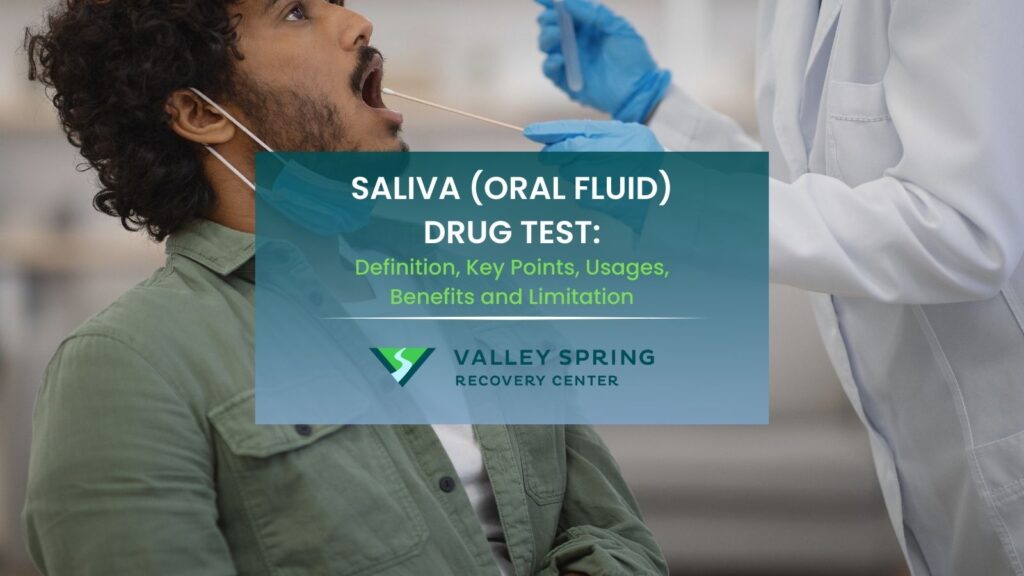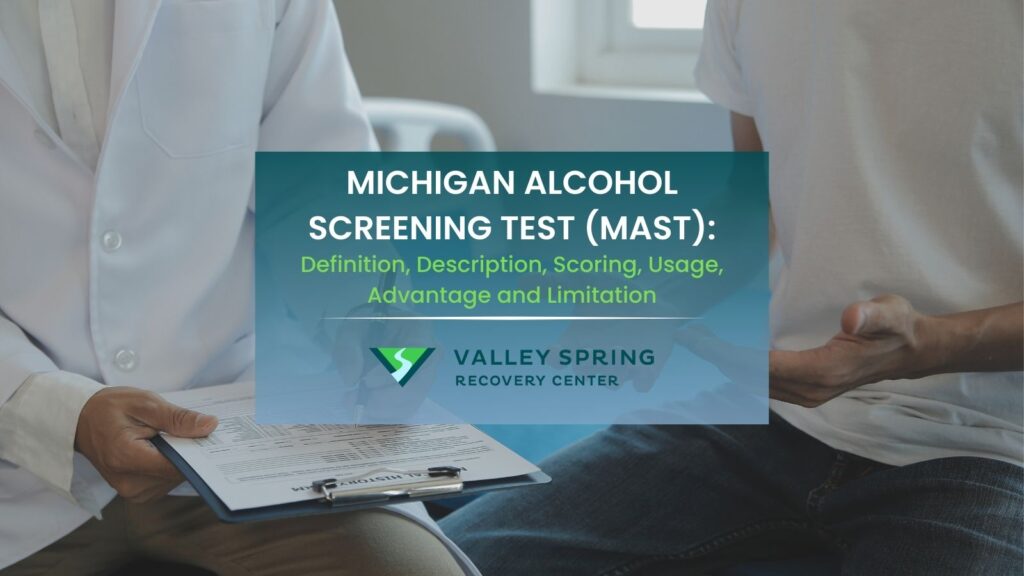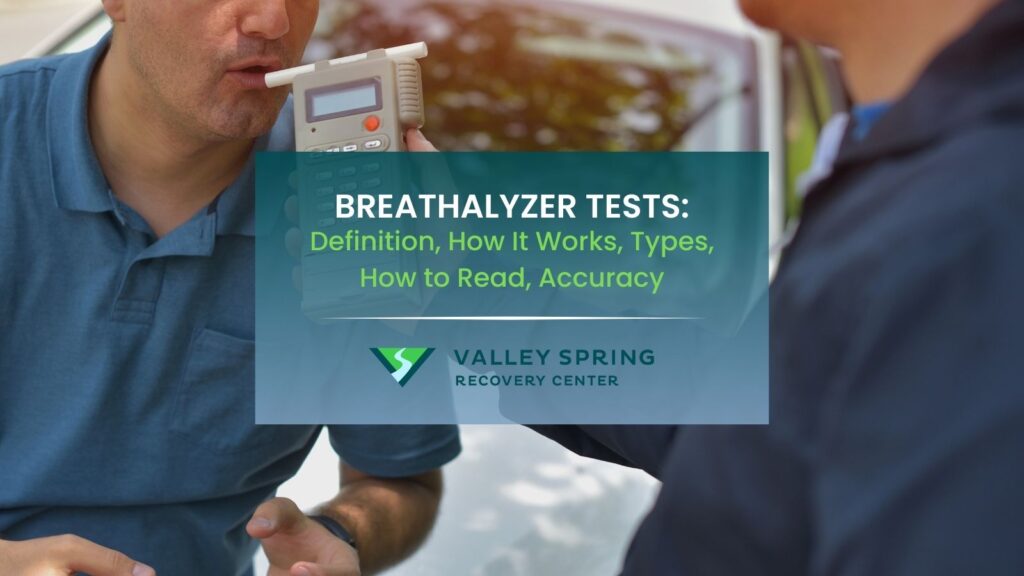The AUDIT is a standardized and internationally recognized screening tool used to assess alcohol consumption patterns and identify individuals at risk for alcohol-related problems. It provides a comprehensive evaluation of quantity, frequency, consequences, and dependence symptoms, guiding healthcare professionals in appropriate interventions and referrals.
The AUDIT is scored by assigning points to individual responses on the questionnaire and summing them up to obtain a total score, with higher scores indicating a higher likelihood of alcohol-related problems.
The benefits of the AUDIT tool include standardized assessment, efficiency in administration, comprehensive evaluation of alcohol use, international recognition, validated reliability, versatility in healthcare settings, identification of risk levels, and guidance for appropriate interventions.
The limitations of the AUDIT tool include self-report bias, cultural and contextual limitations, potential difficulty in assessing specific populations, lack of diagnostic capability, limited focus on consequences, and reliance on predefined cutoff scores.
What is the Alcohol Use Disorders Identification Test (AUDIT)?
The Alcohol Use Disorders Identification Test (AUDIT) is a screening tool designed to assess a person’s alcohol consumption habits and identify potential alcohol-related problems. It is used to determine if someone is at risk for developing an alcohol use disorder.
The AUDIT consists of a series of questions that cover various aspects of alcohol consumption. These questions inquire about the frequency and quantity of alcohol consumed, as well as the negative consequences associated with drinking.
The Alcohol Use Disorders Identification Test (AUDIT) was developed by the World Health Organization (WHO) in the early 1980s. It was created to assist healthcare professionals in identifying people who may have alcohol-related problems.
According to an AUDIT publication on AUDIT Screen,The AUDIT has become the world’s most widely used alcohol screening instrument since its publication in 1989. It is currently available in approximately 40 languages, indicating its global reach and applicability.
The AUDIT was designed to be a simple and effective screening tool that could be used in various healthcare settings to assess alcohol consumption patterns, detect risky drinking behaviors, and prompt appropriate interventions or referrals for further evaluation and treatment.
How is the AUDIT tool Used?
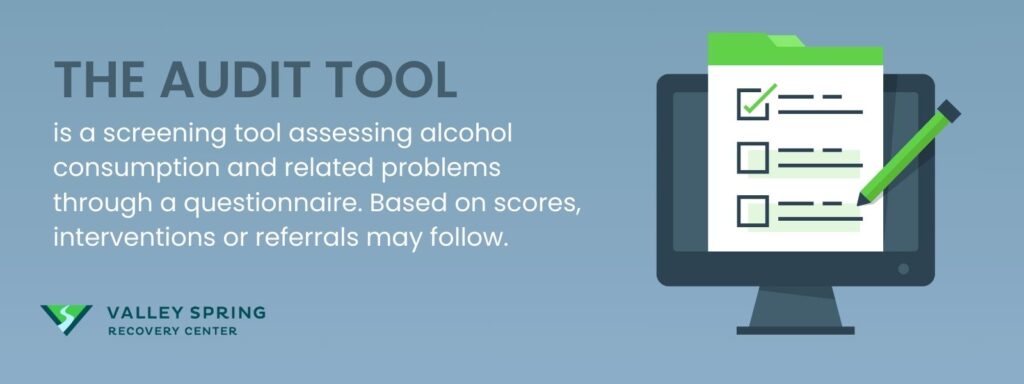
The AUDIT tool is used as a screening instrument to assess alcohol consumption and identify potential alcohol-related problems. It is administered as a questionnaire consisting of multiple-choice questions related to alcohol use. The individual being assessed provides answers based on their own drinking habits and experiences.
Based on the AUDIT score, further actions can be taken. If the score indicates low or no risk, no further intervention is needed. However, if the score suggests a potential alcohol-related problem or a higher risk, healthcare providers will offer appropriate advice, interventions, or referrals to specialized services for further evaluation, treatment, or support.
A publication by the World Health Organization, titled AUDIT : the Alcohol Use Disorders Identification Test : guidelines for use in primary health care presents guidelines on how the tool is used, stating that the AUDIT is used in various healthcare settings, such as primary care clinics, emergency departments, substance abuse treatment centers, or research studies, to help identify individuals who will benefit from intervention or additional assessment related to their alcohol consumption.
What are Some Questions That the AUDIT Tool Contains?
The AUDIT tool consists of 10 questions that cover various aspects of alcohol consumption, and they include:
- How often do you have a drink containing alcohol?
- How many standard drinks do you have on a typical day when you are drinking?
- How often do you have six or more drinks on one occasion?
- How often during the last year have you found that you were not able to stop drinking once you had started?
- How often during the last year have you failed to do what was normally expected from you because of your drinking?
- How often during the last year have you needed a first drink in the morning to get yourself going after a heavy drinking session?
- How often during the last year have you had a feeling of guilt or remorse after drinking?
- How often during the last year have you been unable to remember what happened the night before because you had been drinking?
- Have you or someone else been injured as a result of your drinking?
- Has a relative, friend, doctor, or another healthcare professional expressed concern about your drinking or suggested you cut down?
After the questionnaire is completed, the responses are scored to obtain a total AUDIT score. The score helps determine the level of risk or potential alcohol-related problems. Healthcare professionals, such as doctors, nurses, counselors, or researchers, use predefined cutoff scores to interpret the results.
How is the AUDIT Tool Scored and Interpreted?
The AUDIT tool is scored by assigning a numerical value to each response provided by the individual being assessed. Here is an interpretation of the AUDIT scores:
- Score of 0-7: This range indicates low-risk alcohol consumption. It suggests that you’re drinking within recommended limits and don’t require further intervention.
- Score of 8-15: This range indicates hazardous or harmful alcohol use. It suggests that your drinking patterns are putting you at risk for developing alcohol-related problems. Brief interventions or further assessment will be appropriate.
- Score of 16 or higher: This range indicates a high likelihood of alcohol dependence or significant alcohol-related problems. It suggests that you have an alcohol use disorder and will benefit from further evaluation and specialized treatment.
It’s important to note that the cutoff scores and interpretation vary depending on the context, guidelines, or healthcare provider’s judgment.
The AUDIT score is a helpful tool to identify individuals who need intervention or further assessment related to their alcohol consumption.
How does the AUDIT differ from other alcohol screening tools?
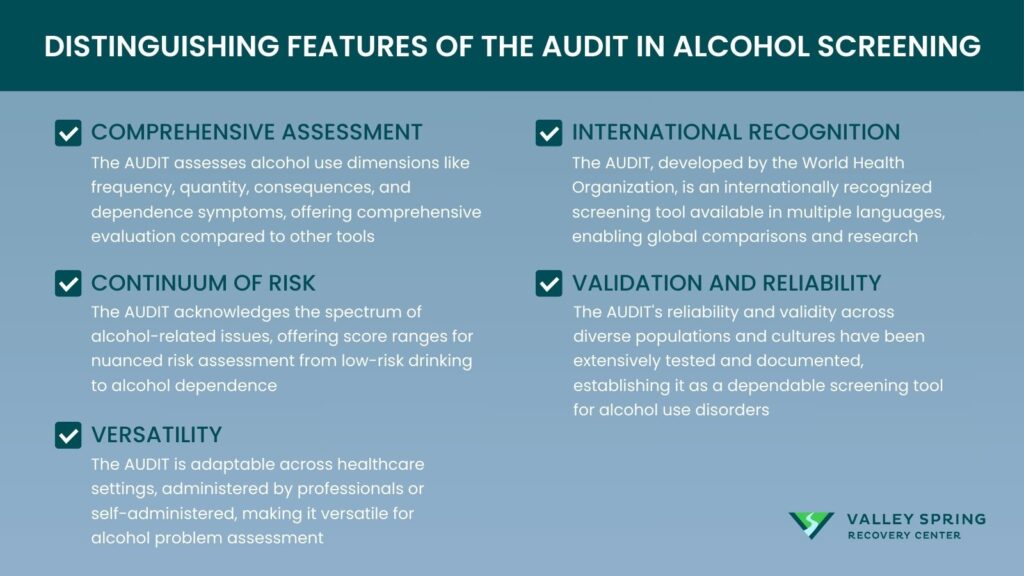
The AUDIT differs from other alcohol screening tools because of its comprehensive assessment, international recognition, continuum of risk, validation and reliability, and versatility.
1. Comprehensive assessment
The AUDIT covers a range of alcohol-related dimensions, including frequency of drinking, quantity consumed, harmful consequences, and dependence symptoms. It provides a more comprehensive assessment of alcohol use and related problems compared to some other screening tools that focus on specific aspects, such as quantity or consequences alone.
2. International recognition
The AUDIT is widely recognized and used internationally. It was developed by the World Health Organization (WHO) and has been translated into multiple languages. Its widespread adoption and use in various countries make it a globally accepted screening tool, facilitating comparisons and research across different populations.
3. Continuum of risk
The AUDIT recognizes that alcohol-related problems exist on a continuum, from low-risk drinking to alcohol dependence. It provides different score ranges to indicate low-risk, hazardous or harmful use, and potentially alcohol-dependent patterns, allowing for a more nuanced interpretation of alcohol-related risks.
4. Validation and reliability
The AUDIT has undergone rigorous testing and validation across different populations and cultures. Its psychometric properties, such as reliability and validity, have been well-documented, ensuring that it is a reliable tool for screening alcohol use disorders.
A publication by the U.S. Department of Veterans Affair revealed that the AUDIT has been extensively validated in various populations and settings, including primary care, emergency departments, and general populations, showing that the tool has good sensitivity and specificity in detecting alcohol-related problems
5. Versatility
The AUDIT can be used in various healthcare settings, including primary care, emergency departments, and specialized addiction treatment centers. It is administered by healthcare professionals, researchers, or even self-administered in some cases, making it a versatile tool for assessing alcohol-related problems.
It’s worth noting that while the AUDIT is a widely used and validated screening tool, other screening tools such as the CAGE questionnaire, the T-ACE, and the SMAST-G are also used in specific contexts or populations to assess alcohol use disorders.
What are the Benefits of the AUDIT Tool?
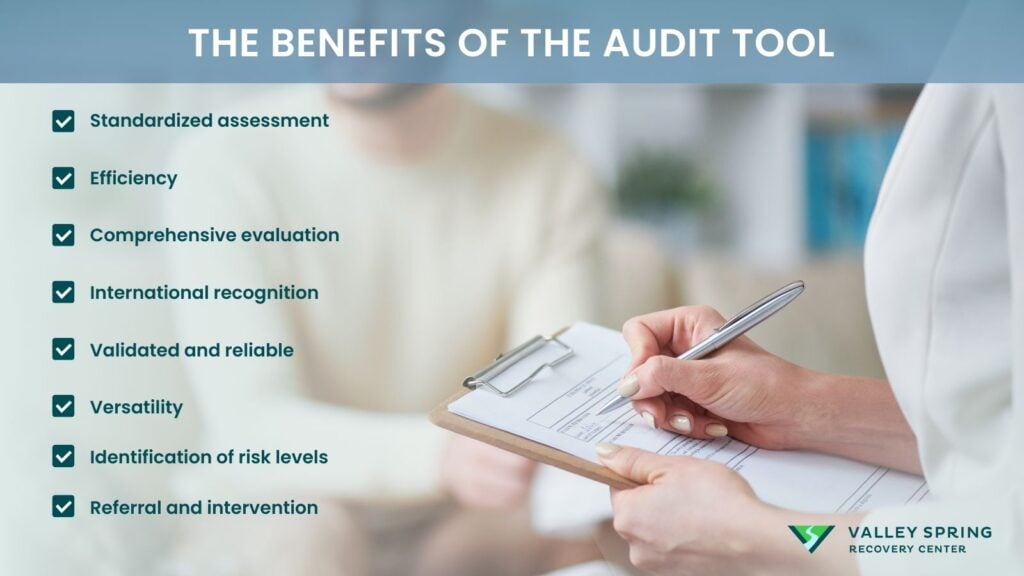
The benefits of the AUDIT tool include standardized assessment, efficiency, comprehensive evaluation, international recognition, and its versatility.
- Standardized assessment: The AUDIT provides a consistent and comparable way to assess alcohol consumption patterns and related problems.
- Efficiency: The AUDIT is quick and easy to administer, saving time for healthcare professionals. In a recent study by Khoury et al. (2020) on the prevalence of alcohol use disorder (AUD) among Lebanese adolescents, the findings revealed that the mean AUDIT score among participants was 6.46 ± 8.44, with a notable 28.0% of adolescents categorized as having a high risk of AUD. Factor analysis confirmed a one-factor solution of the AUDIT scale, indicating its reliability, with a Cronbach’s alpha coefficient of 0.978.
- Comprehensive evaluation: The AUDIT covers multiple dimensions of alcohol use, including frequency, quantity, consequences, and dependence symptoms.
- International recognition: The AUDIT is widely recognized and used internationally, facilitating cross-cultural comparisons and research.
- Validated and reliable: The AUDIT has undergone rigorous testing and has established psychometric properties, ensuring its reliability as a screening tool.
- Versatility: The AUDIT can be used in various healthcare settings and can be administered by healthcare professionals or self-administered.
- Identification of risk levels: The AUDIT scores help categorize individuals into low-risk, hazardous, or potentially alcohol-dependent groups, aiding in targeted interventions.
- Referral and intervention: The AUDIT results guide healthcare professionals in providing appropriate advice, interventions, or referrals for further evaluation and treatment.
Overall, the AUDIT offers a standardized, efficient, and comprehensive approach to identify individuals at risk for alcohol-related problems and guide appropriate interventions.
What are the Limitations of The Audit Tool?
Some of the limitations of the AUDIT tool are:
- Self-report bias: The AUDIT relies on self-reported information, which may be subject to inaccuracies and biases.
- Cultural and contextual limitations: The AUDIT may not fully capture cultural and contextual factors that influence alcohol consumption patterns.
- Limited assessment of specific populations: The AUDIT may not be sensitive enough to identify alcohol-related problems in certain populations or individuals with specific characteristics.
- Lack of diagnostic capability: The AUDIT is a screening tool and does not provide a formal diagnosis of alcohol use disorders.
- Limited focus on consequences: While the AUDIT assesses alcohol-related consequences, it may not comprehensively capture the full range of potential harms or impacts.
- Reliance on cutoff scores: The use of predefined cutoff scores for risk categorization may not account for individual variations or nuances in alcohol-related problems.
Despite these limitations, the AUDIT remains a valuable tool in identifying individuals at risk and guiding appropriate interventions.
What are the different risk levels identified by the AUDIT?
The AUDIT identifies 3 risk levels: low-risk, hazardous or harmful use, and potentially alcohol-dependent. These levels help categorize individuals based on their alcohol consumption patterns and provide guidance for targeted interventions and treatment approaches.
Can the AUDIT be used for screening both alcohol abuse and dependence?
Yes, the AUDIT can be used to screen for both alcohol abuse and dependence. It assesses various dimensions of alcohol use, including quantity, frequency, and dependence symptoms, providing a comprehensive evaluation of alcohol-related problems and identifying individuals at different levels of risk.
Is the AUDIT suitable for all age groups?
The AUDIT is suitable for adults aged 18 years and older. However, it’s not always accurate or appropriate for certain age groups, such as adolescents or older adults, who have different drinking patterns or specific considerations. Additional assessments or modifications is needed for these populations.
Can the AUDIT be self-administered?
Yes, the AUDIT can be self-administered. It is designed to be a user-friendly tool that you can complete on your own. Self-administration of the AUDIT must be done using paper-and-pencil questionnaires or electronic versions. However, in some cases, healthcare professionals prefer to administer it directly to ensure clarity and address any potential questions.
How does the AUDIT screening tool aid in understanding the accuracy and reliability of breathalyzer tests?
The AUDIT screening tool aids in understanding the accuracy and reliability of breathalyzer tests by providing a broader context of an individual’s drinking habits and behaviors. While breathalyzers offer immediate and objective measurements of blood alcohol concentration (BAC), they do not provide information on long-term drinking patterns or the risk of alcohol use disorders. AUDIT fills this gap by assessing the frequency and impact of alcohol consumption over time. This comprehensive assessment can validate and contextualize breathalyzer results, ensuring a more accurate and reliable understanding of an individual’s alcohol use and potential risks.
Can the AUDIT tool be used in conjunction with the DAST tool?
Yes, the Alcohol Use Disorders Identification Test (AUDIT) and the Drug Abuse Screening Test (DAST) can be used together to assess substance use behaviors comprehensively. While the AUDIT focuses specifically on alcohol use and related problems, the DAST evaluates the use of a wide range of drugs, including both illicit substances and prescription medications used non-medically.
By using both tools in conjunction, healthcare professionals can gain a more comprehensive understanding of an individual’s substance use patterns, identify potential co-occurring substance use disorders, and tailor interventions accordingly. This combined approach allows for a more holistic assessment of substance use behaviors and facilitates targeted treatment planning and referral to appropriate services.
Dr. Michael Olla
All author postsShare This Post


